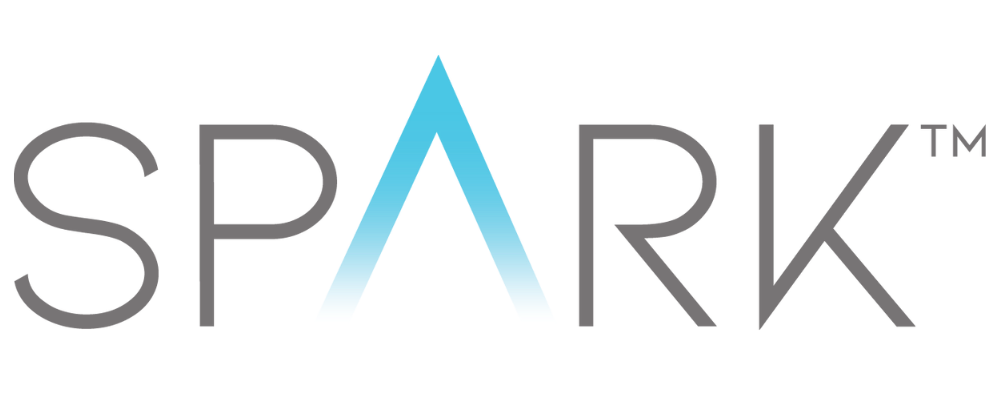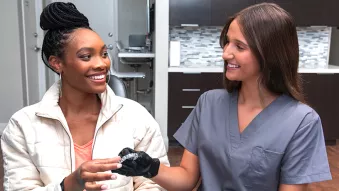Can Aligners
Fix an Overbite?

Before clear aligners, an overbite was corrected using a type of headgear. Even the common colloquialism– “Bucked Teeth,” painted a cartoonish picture. Many people have seen illustrations of over-exaggerated metal encompassing a character's upper jaw like the rings of Saturn. For the longest time, this was the only treatment option and the aesthetic deterred people from fixing their overbite.
Luckily, these days, we have brand-new technologies like aligners that can fix and realign an overbite. Here we will discuss the types of overbites, how clear aligners can remedy them, and what age groups can benefit from them.
What Is An Overbite?
Overbites1 are an extremely common part of human development. Almost everybody has a slight overbite, which allows us to chew all types of food effectively. But sometimes, a person’s top teeth can jet over more than necessary. This is where treatment with aligners is used to fix an overbite.
The orthodontic term for this is a malocclusion. Malocclusion simply means that the alignment of your teeth is slightly off. Sometimes, they are benign, and your orthodontist may not advise action. Other times, a correction may be indicated. Outside aesthetics, aligners can be recommended to fix your overbite if you’re experiencing any of the following:
- Problems chewing
- Jaw straining
- A speech impediment
Types of Overbites
In general, overbites fall into two categories:2 Horizontal and Vertical. The most common form is a horizontal overbite. This is when the top set of teeth expand past the bottom teeth. Horizontal overbites are further subdivided into different classes of malocclusion.3
- A Class I malocclusion4 is considered the most common type of overbite and a possible indication that clear aligners may be needed. This occurs when your molars, or bite, are set in a normal position, but the other teeth are not adequately aligned in some way. If someone has this kind of overbite, it can cause:
- Gaps between the teeth
- Rotated teeth
- Overcrowding
- Open bite
- A Class II malocclusion is when the upper molars are more forward and are not in line with the lower molars. This is usually the result of either a prominent upper jaw or the underdevelopment of the lower jaw. In Class II, you can sometimes observe the lower lip resting behind the upper teeth with the anterior teeth protruding forward.
What To Expect With Clear Aligners
Aligners can fix an overbite, are incredibly simple to use and are one of the most effective treatments. The first thing you need to do is schedule a consultation with an orthodontist. They will ask you a series of questions relating to your medical and dental history as well as do a thorough exam of your face and mouth. This exam allows your orthodontist to have an initial impression of what needs to be done and to what degree.
Imaging and Models
Next, your orthodontist may order a series of X-rays as well as 3-D models of your teeth. This adds to the detail of the initial impression and solidifies your orthodontist's plan. Afterward, they may schedule another consultation or start adding attachments during that same visit if it is warranted.
Attachments and Treatment Plan
Aligners can fix an overbite with the help of attachments. Attachments are small tooth-colored bumps placed on or behind your tooth that help the clear aligners push and pull your overbite into place. Securing them to the teeth doesn’t take long and is part of the foundation on which clear aligner tech is based.
Once the attachments are in place, your orthodontist will explain the course of your clear aligners. The treatment is broken down into stages tailored specifically for your overbite. These are marked with different classes of aligners. These aligners may all look the same since they are clear and are in the general shape of your teeth. But if you compare the first and last stages, you’ll notice that there’s a stark difference in how straight they are. All the ones in between use slight movements to achieve the desired endpoint.
Daily Use
In order to get the best results from your aligners, you will need to wear them for a certain duration, so they can effectively fix your overbite. The recommendation is that you should have them in at least 22 out of the 24 hours in the day. The concept may be similar to braces, but you have more flexibility with the option to take them off for meals and when you brush your teeth. However, this can also make it easy to forget to wear them for the correct amount of time.
Are Aligners Right for You?
Clear aligners are the best option for adolescents and adults that want to improve their overbite. If you are not comfortable with braces, or you want the freedom to remove your alignment apparatus to enjoy a meal, clear aligners may be right for you. Clear aligners can fix Mild to moderate5 overbites with no problem. On top of that, they are capable of fixing more than one issue. Your orthodontist can time the various phases in order to address multiple problems with a single treatment plan.
In terms of effective tech for overbites, none are as innovative and user-friendly as clear aligners. Stick to the program, and before you know it, you’ll have the smile you always wanted. Find a Spark Provider near you today and schedule an appointment to get started!




